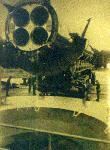




The R-14/SS-5 was a single-stage, storable liquid-propellant, intermediate range ballistic missile. The design of the R-14 missile draw heavily on the previously developed P-12 missile. As with the R-12, the Skean missile was a single stage missile with integral fuel tanks though it was larger and twice the maximum range. According to Western estimates it was capable of delivering a 3,500 lb reentry vehicle containing a nuclear weapon to a maximum operational range of 2,200 nm, and using an inertial guidance system with was assessed as having a CEP of approximately 0.5 nm.
In comparison to the R-12 the increase of the propellant volume was reached through an increase of the diameter of fuel tanks. Fabrication of tanks with aluminum panels processed by a method of chemical contouring was used for the first time. The propulsion system of the R-14 consists of two identical blocks, each with a two-chamber combustion engine, a turbopump unit, gas generator and automatic control system, as well as a four chambered control motor. The use of hypergolic [self igniting] asymmetrical dimethylhydrazine allowed an increased specific impulse. For the first time a gas generator [instead of hydrogen peroxide] was used to power the main propellant components. The flight control still relied on jet vanes. Unlike the previous single-stage rockets, the R-14 used an efficient system of draining the propellant tanks to reduce required propellant mass.
The R-14 marked the first use of a gyro-stabilized platform as part of the autonomous inertial guidance system, allowing fewer instrumental errors and improving accuracy. The R-14 also mounted three solid-propellant retrorockets to prevent accidental collision of the booster with the nose cone after separation. Despite of its substantial longer range, the R-14 demonstrated the same accuracy as the R-12, though given its heavier payload its nose cone was blunted. According to Western intelligence the Mod 1 reentry vehicle had a ballistic coefficient of 1300 lb per sq ft.
The development of the R-14 was authorized on 02 July 1958. The authorization provided for the construction of a missile with an approximate range of 4,000 km, surpassing the R-12 by 2,000 km. The designer was M.K. Yangel of KB Yuzhnoye (OKB-586). The preliminary design was completed in December 1958. Flight tests of the R-14 began in July 1960 [Western sources suggest a first flight in June 1960] and were finished between December 1960 and February 1961. On 24 April 1961 deployment of the R-14 missile began. According to Western intelligence the initial operational capability with the Mod 1 reentry vehicle and soft sites was achieved in late 1961.
In May I960 the development of the R-14U missile for silo and surface launchers began. The first flight test of the silo-launched R-14U was carried out on 12 January 1962, the surface-launched version was first tested on 11 February 1962. Both were subsequently introduced into the Strategic Missile Forces. The first regiment of surface-based R-14s was put on alert on 01 January 1962. According to Western intelligence an initial operational capability with hard sites was achieved in early 1963, and the initial operational capability with the Mod 2 reentry vehicle was achieved in mid-1963.
The SS-5 was deployed at both soft and hard launch sites. Soft-site reaction time in the normal readiness condition is one to three hours. Hard-site reaction time in the normal readiness condition is five to fifteen minutes. Allowable hold time (reaction time equals three to five minutes) was many hours for soft sites and many days for hard sites. Maximum operational launcher deployment was reached in 1964. Between 1965 and 1969 the deployment of the R-14 and R-14U reached its peak with 97 launchers. Some phaseout of soft sites beginning in 1969 and some phase-out of hard sites beginning in 1971. In the period between 1978 and 1983 they were replaced by SS-20 Pioneer missiles, and in 1984 they were totally withdrawn from service.
The Intermediate-Range and Shorter-Range Nuclear Forces [INF] Treaty was signed on 08 December 1987 and entered into force on 01 June 1988. The fundamental purpose of the INF Treaty was to eliminate and ban US and former USSR (FSU) ground-launched ballistic and cruise missiles, as well as associated support equipment, with ranges between 500 and 5500 kilometers. SS-4 and SS-5 missiles and components were eliminated at Lesnaya. Beginning in 1988 the six remaining non-deployed missiles were dismantled in compliance with the INF Treaty. The sixth and final SS-5 missile was eliminated at the Lesnaya Missile Elimination Facility on 09 August 1989.
Specifications | |||||
|
DIA |
SS-5 |
SS-5 |
|||
|
NATO |
Skean |
Skean |
|||
|
Bilateral |
R-14 |
R-14U |
|||
|
Service |
R-14 |
R-14U (Chusovaya) |
|||
|
OKB/Industry |
8K65 |
8K65U |
|||
|
Design Bureau |
OKB-586 |
OKB-586 (Acad. M. K. Yangel) |
|||
|
Approved |
7/2/1958 |
5/30/1960 |
|||
|
Years of R&D |
1958 - 1960 |
1960 -1962 |
|||
|
Engineering and Testing |
1960 -1961 |
1961 -1962 |
|||
|
First Flight Test |
7/6/1960 |
2/11/62 (1/12/1962) |
|||
|
IOC |
1962 |
1962 |
|||
|
Deployment Date |
4/24/1961 |
1/9/1964 |
|||
|
Type of Warhead |
Single |
Single |
|||
|
Warheads |
1 |
1 |
|||
|
Yield (Mt) |
1.0 or 2.0 -2.3 |
1 x 2.3 |
|||
|
Payload (t) |
1.300 -1.500 or 2.155 |
1.300 -1.500 or 2.155 |
|||
|
Total length (m) |
24.3 - 24.4 |
24.3 -24.4 |
|||
|
Total length w/o Warhead (m) |
21.62 |
21.62 |
|||
|
Missile Diameter (m) |
2.4 |
2.4 |
|||
|
Launch Weight (t) |
86.3 - 87 |
86.3 |
|||
|
Fuel Weight (t) |
79.2 |
79.2 |
|||
|
Range (km) |
4500 or 3200 -3700 |
4500 -3700 |
|||
|
CEP (m) (Russian Sources) |
1250 -1900 |
1250 |
|||
|
CEP (m) (Western Sources) |
900-1900 |
900-1900 |
|||
|
Basing mode |
Ground Based |
Ground and Silo Based |
|||
|
Number of Stages |
1 |
|
Booster guidance system |
Inertial, autonomous |
|
Engine Designation |
RD-216m (8D514,M) |
|
Configuration |
Cluster of two engines |
|
Design Bureau |
Acad. V. P. Glushko OKB-456 |
|
Years R & D |
1958-1960 |
|
Propellants |
Liquid Storable |
|
Fuel |
UDMH |
|
Oxidizer |
AK-27 I = IRFNA =73% HN03 + 27% N204 (NTO) in N02 |
|
Burning time (sec.) |
130 -131 |
|
Thrust Sea Level/Vacuum (Tonnes) |
151.4991/171.075 -177.9Total thrust |
|
Specific Impulse Sea Level/Vacuum (sec.) |
246-248 / 290-291.3 |
|
Canister length (m) N/A Canister length w/o front meters N/A Canister diameter (m) N/A |
|
Hardness |
|
|
Launching Technique |
Hot launched |
|
Deployed boosters |
0 |
|
Test Boosters |
|
|
Warheads Deployed |
0 |
|
Deployment Sites |
INF Treaty Information |
|
Training Launchers |
|
|
Space Booster Variant |
SL-8/C-1 Kosmos, Kosmos-3M |
Historical Review - Western Estimates |
|
| First flight test | June 1960 |
| R&D flight testing probably completed | February 15, 1961 |
| Initial operational capability with Mod 1 reentry vehicle | Late 1961 |
| Hard site tests began | Mid 1962 |
| New series of flight tests began | July 12, 1962 |
| Deployment to Cuba began | 1962 |
| Initial operational capability with hard sites | Early 1963 |
| Initial operational capability with Mod 2 reentry vehicles | Mid 1963 |
| Maximum operational launcher inventory | 1964 |
| First public display. | November 7, 1964 |
| Phase-out of soft sites began | 1969 |
| Phase-out of hard sites began | 1971 |




